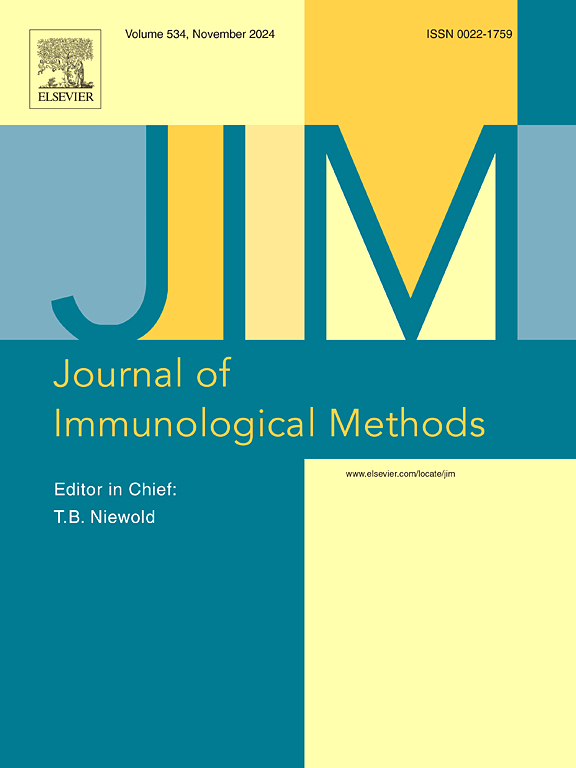In vitro and in vivo lipopolysaccharide-driven activation of human neutrophils in healthy volunteers as a tool for clinical drug development
IF 1.6
4区 医学
Q4 BIOCHEMICAL RESEARCH METHODS
引用次数: 0
Abstract
Neutrophils are an emerging target for therapeutical intervention in both autoimmune diseases as well as cancer. Since healthy humans lack constitutive neutrophil activation, induction of neutrophil activation is necessary to evaluate investigational compounds and can be achieved via intravenous administration of lipopolysaccharides (LPS). Furthermore, LPS stimulation can be performed ex vivo during clinical trials, and in vitro for pre-clinical analysis. Therefore, we aimed to provide a time course of neutrophil responses after in vivo LPS administration using samples from human endotoxemia trials and compared this to in vitro LPS stimulated whole blood cultures. We performed shotgun proteomics on in vivo stimulated neutrophils, and measured neutrophil activation by flow cytometry using CD11b and CD62L as activation markers and elastase, MPO, LL37 and nucleosome levels as degranulation and NETosis markers. Neutrophil numbers rapidly increased after LPS administration. In line, we found significant increases in neutrophil activation and degranulation markers both in vitro as well as in vivo, which all returned to baseline within 24 h. Degranulation proteins and NETosis related nucleosomes rapidly increased after LPS administration (1 h after exposure) in vivo, while higher concentrations of LPS were necessary in vitro. Lastly, shotgun proteomics revealed little but significant differences in the neutrophil proteome after in vivo LPS administration, pointing to degranulation after LPS stimulation. Both, the in vitro whole blood LPS stimulation assay and the human endotoxemia model, could be valuable tools for evaluation of the effects of future drugs modulating neutrophil responses during preclinical and clinical development.
体外和体内脂多糖驱动的人体中性粒细胞在健康志愿者中的激活作为临床药物开发的工具
中性粒细胞是自身免疫性疾病和癌症治疗干预的新兴靶点。由于健康人缺乏组成性中性粒细胞激活,因此诱导中性粒细胞激活对于评估研究化合物是必要的,并且可以通过静脉注射脂多糖(LPS)来实现。此外,LPS刺激可以在体外进行临床试验,也可以在体外进行临床前分析。因此,我们的目的是利用来自人类内毒素血症试验的样本,在体内给药后提供中性粒细胞反应的时间过程,并将其与体外LPS刺激的全血培养进行比较。我们对体内受刺激的中性粒细胞进行了散弹枪蛋白质组学研究,并使用CD11b和CD62L作为活化标记物,使用弹性蛋白酶、MPO、LL37和核小体水平作为脱粒和NETosis标记物,通过流式细胞术测量了中性粒细胞的活化。LPS处理后中性粒细胞数量迅速增加。与此同时,我们发现体外和体内的中性粒细胞活化和脱粒标志物显著增加,在24小时内都恢复到基线水平。体内给脂多糖后(暴露后1小时),脱粒蛋白和NETosis相关核小体迅速增加,而体外则需要更高浓度的脂多糖。最后,霰弹枪蛋白质组学显示,体内LPS刺激后中性粒细胞蛋白质组差异不大,但差异显著,表明LPS刺激后出现脱粒。体外全血LPS刺激实验和人内毒素血症模型都可以作为评估未来药物在临床前和临床开发中调节中性粒细胞反应效果的有价值的工具。
本文章由计算机程序翻译,如有差异,请以英文原文为准。
求助全文
约1分钟内获得全文
求助全文
来源期刊
CiteScore
4.10
自引率
0.00%
发文量
120
审稿时长
3 months
期刊介绍:
The Journal of Immunological Methods is devoted to covering techniques for: (1) Quantitating and detecting antibodies and/or antigens. (2) Purifying immunoglobulins, lymphokines and other molecules of the immune system. (3) Isolating antigens and other substances important in immunological processes. (4) Labelling antigens and antibodies. (5) Localizing antigens and/or antibodies in tissues and cells. (6) Detecting, and fractionating immunocompetent cells. (7) Assaying for cellular immunity. (8) Documenting cell-cell interactions. (9) Initiating immunity and unresponsiveness. (10) Transplanting tissues. (11) Studying items closely related to immunity such as complement, reticuloendothelial system and others. (12) Molecular techniques for studying immune cells and their receptors. (13) Imaging of the immune system. (14) Methods for production or their fragments in eukaryotic and prokaryotic cells.
In addition the journal will publish articles on novel methods for analysing the organization, structure and expression of genes for immunologically important molecules such as immunoglobulins, T cell receptors and accessory molecules involved in antigen recognition, processing and presentation. Submitted full length manuscripts should describe new methods of broad applicability to immunology and not simply the application of an established method to a particular substance - although papers describing such applications may be considered for publication as a short Technical Note. Review articles will also be published by the Journal of Immunological Methods. In general these manuscripts are by solicitation however anyone interested in submitting a review can contact the Reviews Editor and provide an outline of the proposed review.

 求助内容:
求助内容: 应助结果提醒方式:
应助结果提醒方式:


